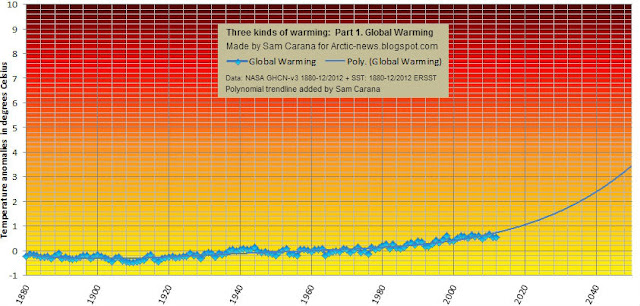 |
| Biggest story of 2013: Huge methane releases from the seafloor of the Arctic Ocean |
The Naval Research Laboratory animation below shows that sea ice extent is growing and that thinner sea ice is getting thicker, which is normal for this time of year. At the same time, the multi-meters thick ice is not increasing in extent nor in thickness. In fact, much multi-meters thick sea ice is being pushed out of the Arctic Ocean. Methane looks to be moving underneath the sea ice along exit currents and entering the atmosphere at the edges of the sea ice, where the sea ice is fractured or thin enough to allow methane to rise.
What is causing the release of this much methane?
To answer this question, let's first examine why the Arctic is warming up more rapidly than other places.
Emissions are causing albedo changes in the Arctic, while emissions from North America are - due to the Coriolis effect - moving over areas off the North American coast in the path of the Gulf Stream (see animation on the right).
These impacts constitute a second kind of warming that is hitting the Arctic particularly hard, on top of global warming.
In addition, there are feedbacks that are further accelerating warming of the Arctic, in particular:
- Snow and ice decline is causing more sunlight to be absorbed in the Arctic (feedback #1).
- As warming in the Arctic accelerates, a weaker Jet Stream lets warmer air move from lower latitudes into the Arctic (feedback #10).
- A weaker Jet Stream further elevates the chance of heat waves warming up the Gulf Stream and warming up rivers that end in the Arctic Ocean (feedback #11). This feedback looks to have caused a lot of seabed warming and subsequent methane releases from the sea floor of the Arctic Ocean.
- The high methane concentrations are in turn further warming up the air over the Arctic (feedback #2).
The diagram below shows thirteen feedbacks that are accelerating warming in the Arctic.
 |
| Hover over each kind of warming and feedback to view more details, click to go to page with further background |
Importantly, on specific days anomalies did reach much higher values. The image below shows how a large area of the Arctic was exposed to 20+ degrees Celsius surface temperature anomalies recently.
 |
| [ click on image to enlarge ] |
By September 2013, surface waters around the Barents Sea Opening were about 5°F (3°C) warmer than they were in 2012. Southern Barents Sea temperatures reached 52°F (11°C), which is 9°F (5°C) warmer than the 1977-2006 average. Warm water from rivers flowing into the Arctic Ocean was highlighted in the earlier post Arctic Ocean is turning red.
The danger is that an ever warmer seabed will result in release of ever larger quantities of methane, escalating into runaway global warming.
What makes this story even bigger is that the media have largely chosen to ignore the threat that methane releases from the Arctic Ocean will escalate into to runaway global warming.
While one can read many stories in the media that global warming was supposed to somehow have 'halted', little attention was given to a recent study that points out that the commonly-used United Kingdom temperature record is actually biased and underestimates warming in certain regions, in particular the Arctic.
 And while the IPCC points out that most of the additional heat associated with global warming goes into oceans (image right), the IPCC fails to highlight the vulnerability of the Arctic Ocean.
And while the IPCC points out that most of the additional heat associated with global warming goes into oceans (image right), the IPCC fails to highlight the vulnerability of the Arctic Ocean.Indeed, perhaps the biggest story of the year is the question why the IPCC has decided not to warn people about the looming Arctic methane threat, ignoring the need for comprehensive and effective action such as discussed at the Climate Plan Blog.
Related
- Ocean heat: Four Hiroshima bombs a second: how we imagine climate change
- (Three kinds of) Warming in the Arctic
Feedbacks
- Albedo: snow and ice decline causing less sunlight to be reflected back into space
http://arctic-news.blogspot.com/2012/07/albedo-change-in-arctic.html - Methane releases warm Arctic air
http://arctic-news.blogspot.com/2013/11/methane-levels-going-through-the-roof.html - As sea ice decline weakens vertical currents, seabed warms
http://arctic-news.blogspot.com/2012/09/arctic-sea-ice-loss-is-effectively-doubling-mankinds-contribution-to-global-warming.html - Storms cause vertical mixing of water
http://arctic-news.blogspot.com/2012/07/arctic-waters-are-heating-up.html - Accelerated Arctic warming causes storms that push cold air of the Arctic
http://arctic-news.blogspot.com/2012/08/diagram-of-doom.html - Extreme weather causing storms that push away sea ice
http://arctic-news.blogspot.com/2012/04/supplementary-evidence-by-prof-peter.html - Extreme weather causing storms that create higher waves, breaking up the sea ice
http://arctic-news.blogspot.com/2012/08/huge-cyclone-batters-arctic-sea-ice.html - Storms creating more wavy waters that absorb more sunlight
http://arctic-news.blogspot.com/2012/08/diagram-of-doom.html - Extreme weather causing fires, etc." title="extreme weather causing fires, etc.
http://arctic-news.blogspot.com/2012/07/how-extreme-will-it-get.html - Weaker polar vortex and jet stream let cold air move out of Arctic
http://arctic-news.blogspot.com/2012/08/opening-further-doorways-to-doom.html - Extreme weather causing warmer waters
http://arctic-news.blogspot.com/2013/12/the-biggest-story-of-2013.html - Snow and ice decline cause seismic activity that destabilizes hydrates
http://arctic-news.blogspot.com/2013/09/methane-release-caused-by-earthquakes.html - Methane releases prevent sea ice from forming
http://arctic-news.blogspot.com/2013/12/methane-emerges-from-warmer-areas.html
Post by Sam Carana.




















 That doesn't seem to reflect the estimates of Dr. Natalia Shakhova. According to older estimates, the total amount of methane in the atmosphere is about 5 Gt. Saying that more than 50 Gt of methane could be stored in hydrates the Arctic seems deceptive and appears to be seriously downplaying a very dangerous situation.
That doesn't seem to reflect the estimates of Dr. Natalia Shakhova. According to older estimates, the total amount of methane in the atmosphere is about 5 Gt. Saying that more than 50 Gt of methane could be stored in hydrates the Arctic seems deceptive and appears to be seriously downplaying a very dangerous situation.


















